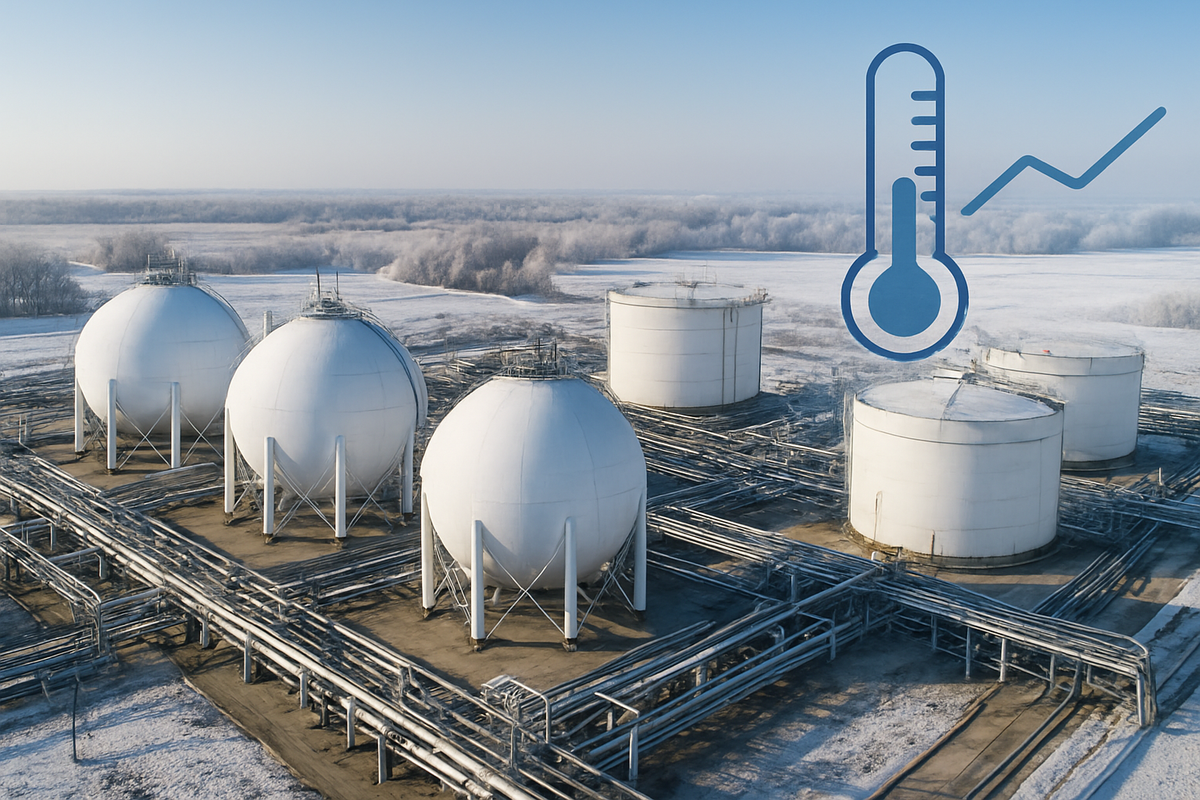
The United States natural gas market is entering the 2025-2026 winter heating season with a robust supply picture, characterized by significantly above-average storage levels and record domestic production. Despite forecasts for overall record demand, primarily driven by surging liquefied natural gas (LNG) exports, a milder near-term weather outlook is exerting downward pressure on natural gas prices, dampening expectations for a significant winter price surge. This delicate balance between strong supply and fluctuating demand is setting the stage for a potentially stable, yet volatile, heating season for consumers and producers alike.
As of November 7, 2025, the U.S. Energy Information Administration (EIA) reported working natural gas in storage at a formidable 3,960 billion cubic feet (Bcf) in the Lower 48 states. This figure not only represents a healthy net increase of 45 Bcf from the previous week but also positions storage levels comfortably above the five-year average, signaling a well-supplied market as the industry transitions from the refill season to the withdrawal period. The market's immediate reaction has been a bearish sentiment, pushing prices below key technical levels, even as the longer-term outlook still bakes in a "winter risk premium" for potential cold snaps.
Inventory Reports and Market Dynamics: A Closer Look
The U.S. natural gas market operates with a keen eye on weekly inventory reports, primarily those released by the EIA. These reports, detailing changes in working gas in underground storage facilities, serve as a critical barometer for supply-demand balances and heavily influence price movements on exchanges like the New York Mercantile Exchange (NYMEX). The recent EIA report for the week ending November 7, 2025, confirming 3,960 Bcf in storage, underscored the market's current oversupply. This figure is approximately 4.5% to 5% above the five-year (2020-2024) average of 3,788 Bcf, and comparable to the high levels seen at the start of last winter, which was the highest since 2016.
The timeline of events leading to this moment has been characterized by consistent, strong domestic natural gas production, which has reached record highs, touching 109.3 Bcf/d in November. This robust output, combined with a refill season that concluded with over 3,900 Bcf in storage, has built a significant buffer against potential demand spikes. Key players in this scenario include major natural gas producers like EQT Corporation (NYSE: EQT) and Chesapeake Energy (NASDAQ: CHK), pipeline operators such as Kinder Morgan (NYSE: KMI), and the vast network of utility companies that distribute gas to end-users. Traders and speculators on the NYMEX also play a pivotal role, reacting swiftly to inventory data, weather forecasts, and geopolitical developments.
Initial market reactions to the ample storage levels and milder weather forecasts for late November have been largely bearish. Natural gas futures contracts, particularly for the front-month delivery, have experienced downward pressure. However, the market is not entirely complacent; December, January, and February NYMEX contracts are still settling comfortably above $4.00 per million British thermal units (MMBtu), indicating that a "winter risk premium" remains priced in. This premium reflects the inherent uncertainty of winter weather and the potential for sudden, severe cold snaps to rapidly deplete inventories, leading to price spikes. The anticipation of the first net withdrawal of the heating season, projected by NGI for the week ending November 14, signifies the official shift in market dynamics from storage building to consumption.
Companies Navigating the Natural Gas Landscape
The current natural gas market conditions present a mixed bag of opportunities and challenges for public companies across the energy sector. Companies heavily involved in natural gas exploration and production (E&P) are particularly sensitive to price fluctuations.
Potential Winners:
- Utility Companies: Natural gas distribution companies, such as Consolidated Edison (NYSE: ED) or Sempra Energy (NYSE: SRE), often benefit from lower and more stable natural gas prices, as it reduces their input costs and can lead to more predictable pricing for consumers. This stability can improve their profit margins and reduce regulatory scrutiny over high consumer bills.
- Industrial Consumers: Industries that rely on natural gas as a feedstock or for energy, like chemical manufacturers or certain heavy industries, will see their operating costs decrease with lower gas prices, potentially boosting profitability.
- LNG Export Terminal Operators: Companies like Cheniere Energy (NYSE: LNG), which operates major LNG export facilities, are poised to benefit from the strong global demand for LNG. While domestic prices might be lower, the arbitrage opportunity between U.S. Henry Hub prices and higher international prices (e.g., in Europe or Asia) can still drive significant revenues for these operators, especially with new capacity coming online, such as Plaquemines LNG.
Potential Losers (or those facing headwinds):
- Natural Gas Producers: E&P companies focused solely or primarily on natural gas, such as EQT Corporation (NYSE: EQT) or Southwestern Energy (NYSE: SWN), may face reduced revenues and profitability if sustained low natural gas prices persist. While record production has filled storage, it also contributes to the oversupply, potentially eroding their margins. They might need to adjust capital expenditure plans or curtail production if prices fall too low.
- Midstream Companies (with exposure to price risk): While many midstream companies like Kinder Morgan (NYSE: KMI) or Energy Transfer (NYSE: ET) operate on fee-based contracts, some have exposure to commodity prices through their gathering and processing segments. Lower natural gas prices could impact the profitability of these specific segments or reduce volumes if producers scale back activity.
- Coal Producers: While not directly in the natural gas market, sustained low natural gas prices can make gas a more competitive fuel for electricity generation, potentially displacing coal and further pressuring coal producers like Peabody Energy (NYSE: BTU).
The long-term outlook for these companies will depend heavily on the duration of the current price environment, the severity of the winter, and the continued growth of LNG export demand. Producers will need to carefully manage their drilling programs and capital allocation to remain profitable, while utilities and industrial users will likely enjoy the benefits of more affordable energy.
Wider Significance: Trends and Ripple Effects
The current state of the natural gas market, marked by robust storage and a nuanced demand outlook, fits into several broader industry trends. Foremost among these is the sustained growth of U.S. natural gas production, which has consistently outpaced domestic demand growth for several years, transforming the U.S. into a net exporter of natural gas. This has been largely driven by advancements in hydraulic fracturing and horizontal drilling, unlocking vast shale gas reserves.
The most significant ripple effect is on the global energy landscape, primarily through the burgeoning LNG export market. The U.S. is solidifying its role as a major global supplier of LNG, providing energy security to allies and diversifying global gas supplies away from traditional sources. This trend is expected to continue, with LNG exports projected to provide the largest incremental call on U.S. natural gas, rising by 3.8 Bcf/d this winter due to new capacity. This global demand acts as a crucial floor for domestic prices, preventing them from collapsing entirely despite high internal supply.
Regulatory and policy implications are also at play. The emphasis on energy transition and decarbonization efforts could influence long-term demand for natural gas, especially in the power sector, where renewables continue to gain market share. However, natural gas is still widely seen as a crucial "bridge fuel" in this transition due to its lower carbon footprint compared to coal and its ability to provide reliable baseload power. Policy decisions regarding new pipeline infrastructure or LNG export facility approvals will also significantly impact future supply and export capacity.
Historically, the natural gas market has always been highly susceptible to weather patterns. Comparisons to similar events often recall winters where unexpected cold snaps led to rapid price spikes (e.g., the Polar Vortex events) or unusually mild winters caused prices to languish. The current situation, with high storage levels combined with a forecast for a potentially milder early winter, mirrors periods where ample supply has created a bearish sentiment, delaying the typical winter inventory drawdowns. However, the increasing role of LNG exports adds a new dimension, linking domestic prices more directly to global energy dynamics than in past decades.
What Comes Next: Navigating Uncertainty
The coming months for the natural gas market will be a dynamic interplay of weather patterns, demand shifts, and global energy developments. In the short term, the primary focus will be on the actual severity of winter weather across key heating regions in the U.S. A sustained period of colder-than-average temperatures could quickly erode the current storage surplus, leading to significant price increases as demand for heating fuel surges. Conversely, a persistently mild winter would likely keep prices subdued, potentially leading to a larger-than-average storage overhang by the end of the heating season.
Longer-term possibilities include continued growth in LNG export capacity, which will increasingly tie U.S. natural gas prices to international markets. This could lead to greater price volatility but also provides a consistent demand sink for abundant U.S. production. Strategic pivots for producers might involve further optimizing drilling programs for efficiency and cost reduction, or even considering temporary production curtailments if prices become uneconomical. Utility companies may explore hedging strategies to lock in natural gas prices for their customers, ensuring stability amidst potential market swings.
Market opportunities could emerge for traders adept at navigating weather-driven volatility, while challenges include managing infrastructure constraints. Despite strong overall supply, bottlenecks in storage and pipelines, particularly in the Northeast and at the Waha Hub in West Texas, could still lead to regional price dislocations and temporary spikes, even if national prices remain low. Potential scenarios range from a "Goldilocks" winter with balanced supply and demand, leading to stable prices, to a "deep freeze" scenario causing rapid inventory draws and price surges, or a "warm winter" scenario where prices remain depressed.
Comprehensive Wrap-Up: A Market in Balance, for Now
The natural gas market is currently characterized by a robust supply-side picture, with ample storage and record production providing a significant cushion as the U.S. enters the 2025-2026 winter heating season. The key takeaway is that despite projections for record overall demand, largely fueled by burgeoning LNG exports, the immediate outlook for domestic natural gas prices is tempered by milder near-term weather forecasts and the sheer volume of gas in storage. This has created a bearish sentiment in the short term, pushing prices lower than might typically be expected at the start of winter.
Moving forward, the market remains fundamentally balanced, but with significant potential for volatility. The "winter risk premium" priced into future contracts underscores the market's awareness that a severe cold snap could quickly change the narrative. Investors should closely watch weekly EIA storage reports, updated weather forecasts (especially for January and February), and any developments in global LNG demand or infrastructure. The interplay between domestic production discipline, the pace of LNG export growth, and the unpredictable nature of winter weather will dictate price movements and profitability for energy companies in the coming months. While the current conditions suggest a relatively stable winter for natural gas consumers, the inherent volatility of this commodity means that market participants must remain vigilant.
This content is intended for informational purposes only and is not financial advice






